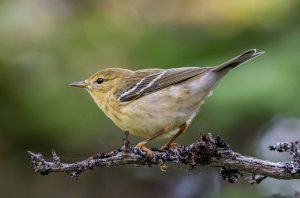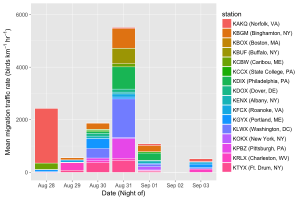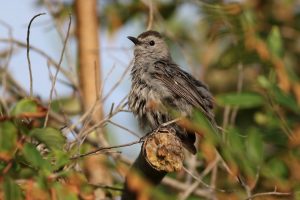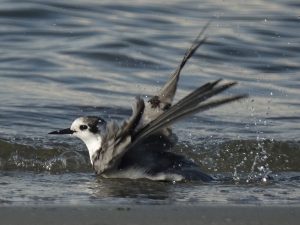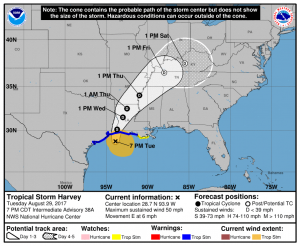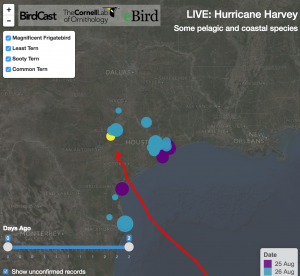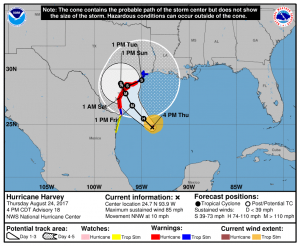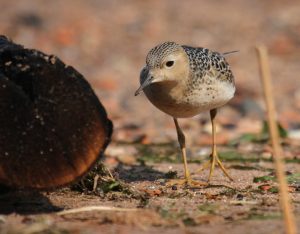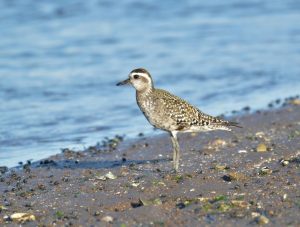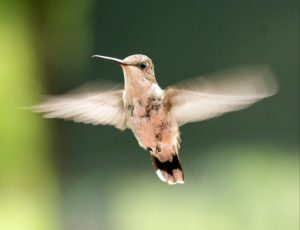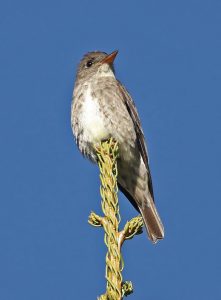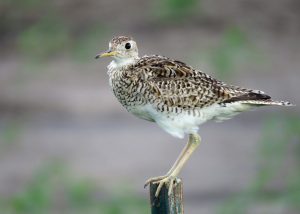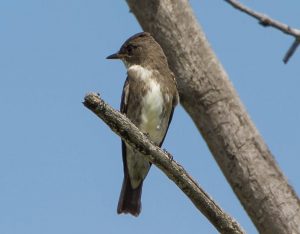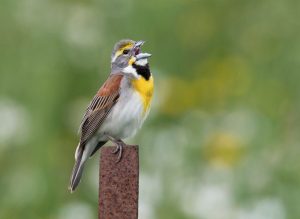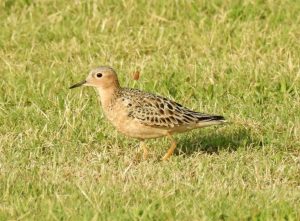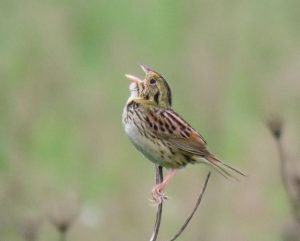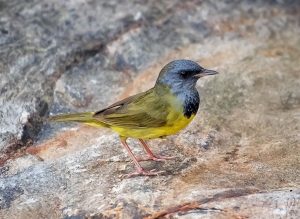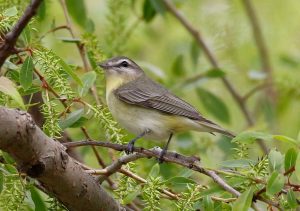News
Light to locally heavy flights, particularly in the first half of the period, occurred in the West and featured Common Loon, Black-bellied Plover, Say's Phoebe, Swainson's Thrush, White-crowned Sparrow, and Lincoln's Sparrow, while numerous moderate to heavy flights featuring Gray-cheeked Thrush, Swainson's Thrush, Blackpoll Warbler, Tennessee Warbler, Orange-crowned Warbler, Wilson's Warbler, and Lincoln's Sparrow were the norm across the East following the passages of a significant frontal boundary. Read more...
Welcome to our first fall 2017 installment of the traffic report describing northeast US nocturnal bird migration traffic rates, as calculated from a completely automated pipeline of algorithms. The images you see in Traffic Reports present the migration traffic rate (MTR), direction of bird movement, and speed of bird movement. See our first report or scientific paper for more information […] Read more...
Pulses of early and mid period favorable migration conditions will bring similarly time pulses of moderate flights to many areas of the West featuring American White Pelican, Killdeer, Elegant Tern, Cassin's Vireo, Yellow Warbler, and MacGillivray's Warbler, while a significant mid period cold front will spawn moderate to very heavy flights in the East featuring Buff-breasted Sandpiper, Common Nighthawk, Least Flycatcher, Olive-sided Flycatcher, Warbling Vireo, numerous warblers, and Bobolink. As the remnants of Harvey plod through the eastern US early in the period, a new and currently strong tropical system (Irma) will be approaching the southeastern US by the end of the period; BirdCast will be watching closely. Read more...
Continental Summary Light to moderate movements were the norm in the West and featured American Wigeon, Northern Pintail, Green-winged Teal, Wilson’s Warbler, Townsend’s Warbler, and Green-tailed Towhee, while moderate to locally heavy flights were common in the East and featured American Golden-Plover, Swainson’s Thrush, Canada Warbler, Nashville Warbler, Bay-breasted Warbler, and Baltimore Oriole. Hurricane Harvey […] Read more...
Hurricane Harvey came ashore on the central Texas coast last week with an almost unimaginable combination of destructive winds and rain. Team BirdCast has been tracking the avian fallout from this storm, perhaps a brief respite for some to escape from the horrible scenes of the devastation in Harvey's wake. Read more...
Hurricane Harvey's path of destruction has seen unprecedented and catastrophic events in coastal Texas. Some birders have been out safely documenting what they have seen, and numerous typically pelagic or near shore species have been displaced far inland from the coast. Read more...
Team BirdCast monitors birds and their associations with hurricanes when we can, as they provide rare opportunities to study entrainment and displacement of birds. Such storms are dangerous in the extreme, no matter what intensity, and Hurricane Harvey proves no exception. This storm is coming ashore as a Category 4 Hurricane, very strong and very dangerous! Read more...
Hurricane Harvey is rapidly intensifying in the Gulf of Mexico. This dangerous storm is forecast to strike the Texas coast on Friday night or Saturday morning as a major hurricane and then meander in the immediate vicinity of the coast for several days. Entrainment and displacement of seabirds is highly likely. Read more...
Moderate movements featuring Northern Shoveler, Killdeer, Belted Kingfisher, Warbling Vireo, MacGillivray's Warbler, Yellow Warbler, and Western Tanager are likely in many areas of the West, while the East will see scattered moderate to heavy pulses that feature Blue-winged Teal, Common Nighthawk, Least Flycatcher, Eastern Wood-Pewee, Yellow Warbler, Chestnut-sided Warbler, and Summer Tanager. The dangerous Hurricane Harvey will bring typical Gulf of Mexico bound seabirds and near shore species to inland locations from Texas and Louisiana to Arkansas over the course of the week. Read more...
Light to moderate flights featuring Western Grebe, Clark's Grebe, Pectoral Sandpiper, Red-headed Woodpecker, Wilson's Warbler, Townsend's Warbler, and Nashville Warbler were the norm in the West, particularly toward the end of the forecast period, while widespread moderate to locally heavy flights featuring Blue-winged Teal, Northern Shoveler, American Golden-Plover, Yellow-bellied Flycatcher, Nashville Warbler, Wilson's Warbler were the norm for the East. The total solar eclipse of 21 August also featured some interesting "migration" behaviors, please see our post to check out the observations! Read more...
Conditions in the West are favorable for light to moderate migration featuring Green-winged Teal, Northern Shoveler, Red-tailed Hawk, Least Sandpiper, Red-necked Phalarope, Yellow Warbler, and MacGillivray's Warbler in the first half of the forecast period, while moderate to heavy flights of Wood Duck, Lesser Yellowlegs, Least Sandpiper, Ruby-throated Hummingbird, Great Crested Flycatcher, Yellow Warbler, and Baltimore Oriole will follow the passage of a frontal system through the East late in the period. Read more...
Olive-sided Flycatcher is another interesting species on the move that we would like to highlight. With western populations breeding significantly farther south than those in more eastern boreal forests of Canada and the northern tier of the US, the potential to examine patterns of migration progression and differences in migration progression between populations is excellent. Read more...
Upland Sandpipers are on the move (and they have been for a few weeks now). Check out our new map to show the progression of migration for this species! Read more...
Team BirdCast is thrilled to welcome its new members, namely Adriaan Dokter, Kyle Horton, and Cecilia Nilsson. Here’s the team at its first official gathering in Ithaca, NY on 10 August 2017. During fall 2017 look for biographic posts for each of the members, so you can get to know your newest BirdCasters! Read more...
Next Friday, BirdCast begins its official Fall 2017 season of weekly migration forecast and analysis reports. Additionally, we will soon be introducing a few new members of Team BirdCast, some new visualizations, and of course discussions of any interesting patterns we see (or hear). Stay tuned! Read more...
In June 2017 numerous observers around the Northeastern US commented that Dickcissels were more obvious, and in greater numbers, than years in recent memory. Team BirdCast take a quick look at this pattern and how it changed (or not!) over the weeks that followed. Read more...
BirdCast will soon return for Fall 2017! Favorable migration conditions for light to moderate flights become more widespread across the West, while the East sees a mix of marginal and locally favorable migration conditions with local light and moderate movements punctuate an otherwise summery pattern. Please check back in the coming week for the first official forecast and analysis posts! Read more...
Late season light to moderate flights will occur in widely scattered locations during the forecast period and feature Common Nighthawk, Olive-sided Flycatcher, Eastern Kingbird, Cedar Waxwing, and Brewer's Sparrow, while the most widespread favorable conditions for moderate to locally heavy flights featuring Yellow-billed Cuckoo, Acadian Flycatcher, Blue Grosbeak, Dickcissel, Grasshopper Sparrow, and Henslow's Sparrow in the East come during the weekend and end of the period. Read more...
Light to moderate flights becomes increasingly likely in the West and will feature White-throated Swift, Willow Flycatcher, Western Wood-Pewee, Eastern Kingbird, Swainson's Thrush, MacGillivray's Warbler, and Western Tanager, as spring migration winds down, while scattered moderate to heavy flights featuring Black Tern, Common Nighthawk, Chimney Swift, Yellow-billed Cuckoo, Acadian Flycatcher, Philadelphia Vireo, Cedar Waxwing, and Mourning Warbler will punctuate the migration scene in the East amidst unsettled conditions. Read more...
BirdCast regional analyses return after our global big day absence! Widespread light and moderate to locally heavy flights characterized the first days of this long forecast period in the West and featured Willow Flycatcher, Dusky Flycatcher, Western Wood-Pewee, Swainson's Thrush, MacGillivray's Warbler, Yellow Warbler, and Black-headed Grosbeak, while moderate to very heavy flights occurred in the latter two thirds of the two-week period in the East, first in the Plains and then farther to the coasts, featuring Alder Flycatcher, Yellow-bellied Flycatcher, Philadelphia Vireo, Bay-breasted Warbler, Magnolia Warbler, Canada Warbler, and Wilson's Warbler. Read more...

